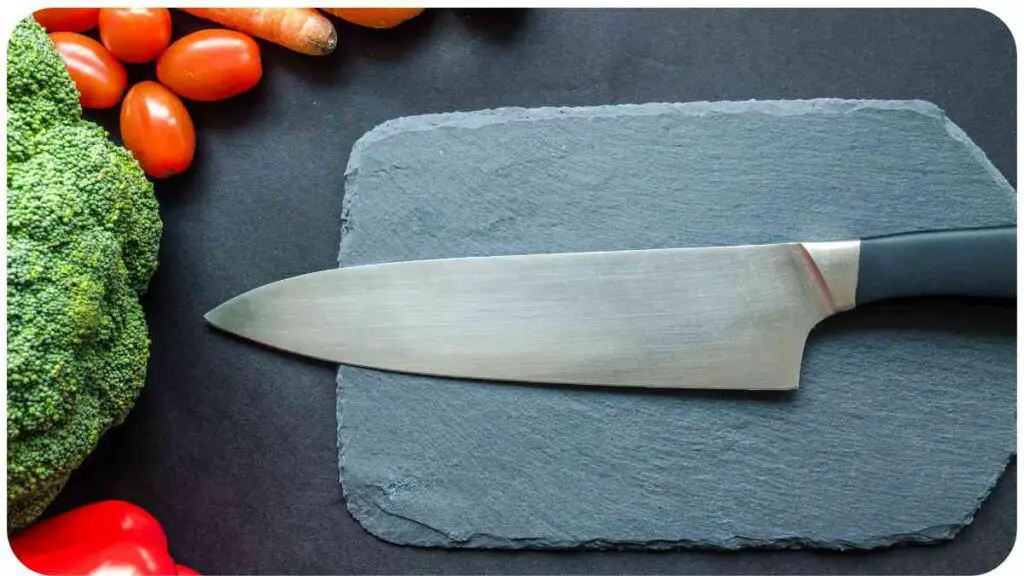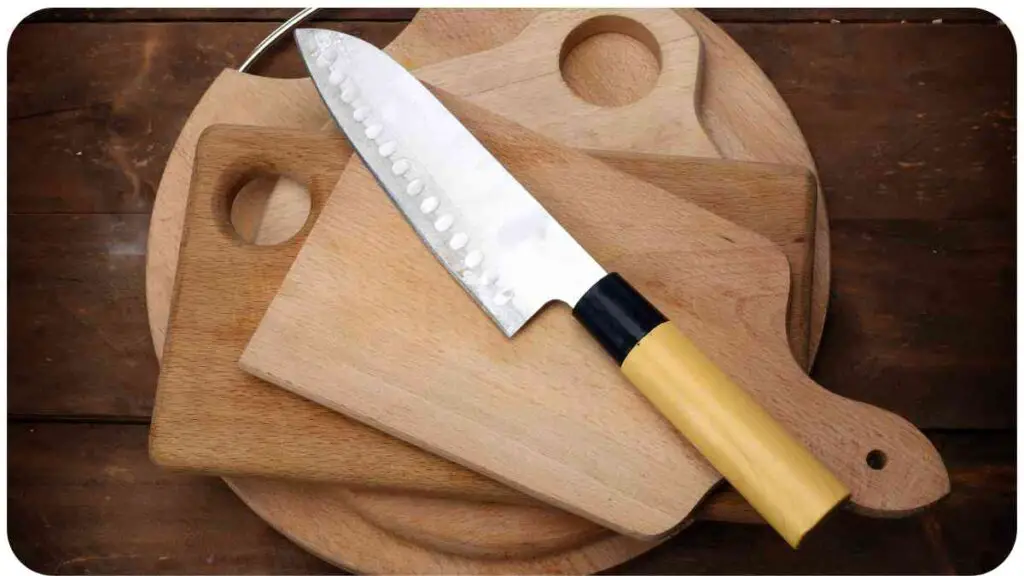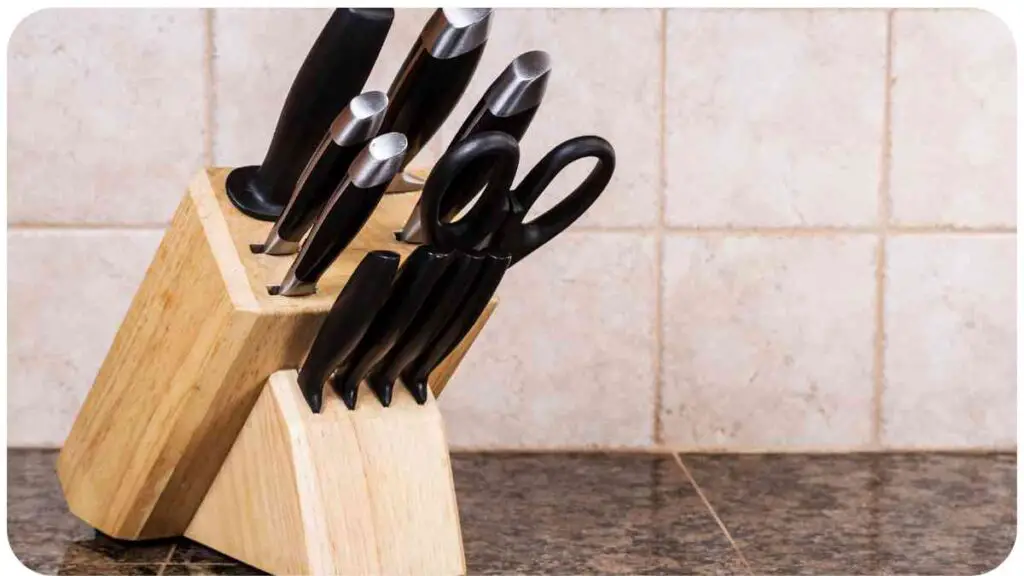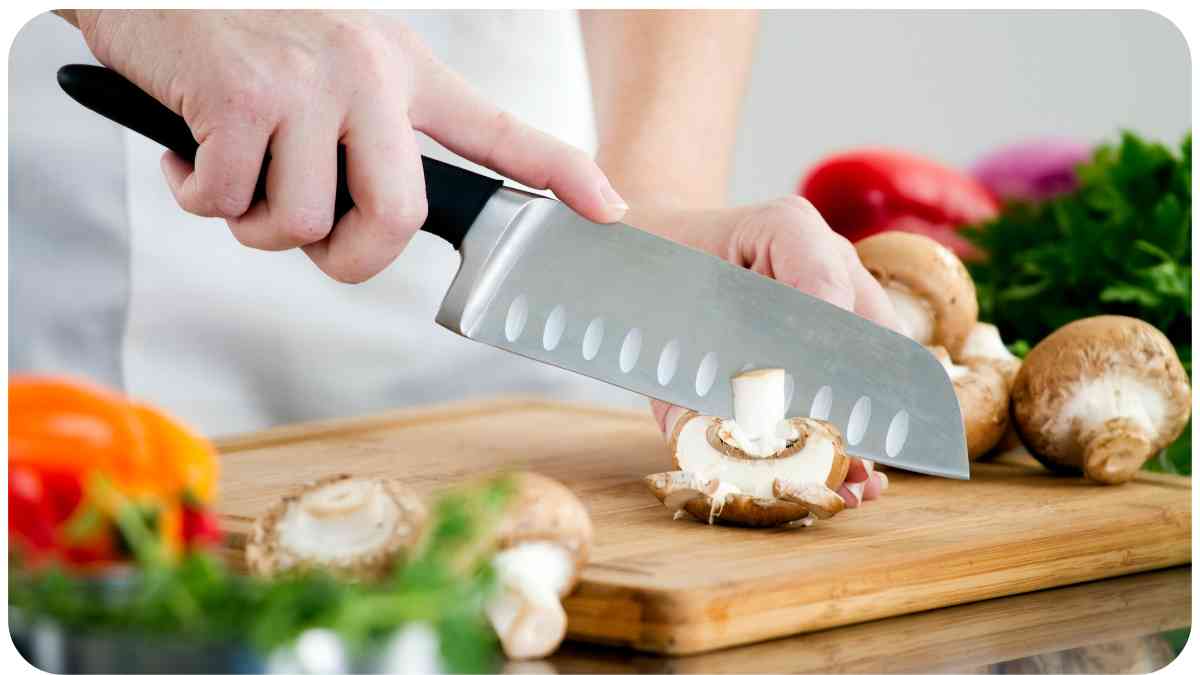Welcome to our guide on mastering kitchen knife skills! Being proficient in knife techniques is an essential skill for every home cook and professional chef alike. With the right knowledge and practice, you can transform the way you prepare ingredients, enhancing both the efficiency and the quality of your cooking.
In this article, we will cover everything you need to know to become a knife handling expert. From understanding the various types of knives and their uses to learning proper handling techniques and maintenance tips, we’ve got you covered. So, let’s dive in and sharpen your knife skills!
| Key Takeaways |
|---|
| Knife skills are an essential part of cooking that can greatly enhance your culinary prowess. |
| Proper knife selection and grip techniques are crucial for achieving precision and control. |
| Regular maintenance, including sharpening and honing, is necessary to keep your knives in optimal condition. |
| Mastering various cutting techniques like slicing, dicing, chopping, mincing, julienne, batonnet, brunoise, and paysanne will add versatility to your culinary repertoire. |
| Safety should always be a top priority when working with knives. Following proper handling techniques, using a stable cutting surface, and maintaining focus can minimize the risk of accidents. |
| Further resources such as articles, books, and online tutorials can provide additional guidance for improving your knife skills. |
2. Importance of Knife Skills in the Kitchen
Have you ever watched a professional chef effortlessly slice and dice ingredients with precision and speed? These chefs have mastered their knife skills, which allows them to work efficiently in the kitchen while achieving consistent results. Developing your own knife skills can have numerous benefits, such as:
- Time-saving: Efficient knife skills can significantly cut down on your preparation time, allowing you to spend more time enjoying the cooking process or with your loved ones.
- Enhanced safety: Proper knife techniques not only improve speed and accuracy but also reduce the risk of accidents and injuries in the kitchen.
- Consistent cooking results: When you can slice or chop ingredients uniformly, your dishes will cook more evenly, resulting in consistently delicious meals.
- Versatility: Expert knife skills open up a world of culinary possibilities. You’ll be able to tackle any recipe and handle a wide range of ingredients with confidence.
“Upgrade your cooking game with these top kitchen tools. Whether you’re enhancing knife skills or exploring new culinary techniques, having the right tools is essential for success.” Upgrade Your Cooking Game
3. Types of Knives and Their Uses

Before we delve into knife skills, it’s essential to familiarize ourselves with the different types of knives available and their specific uses. Each knife has a unique design and purpose, making it suitable for specific tasks. Let’s take a look at some common knives you’ll find in any kitchen:
Table 3.1: Types of Knives and Their Uses
| Knife | Use(s) |
| Chef’s Knife | All-purpose knife suitable for slicing, dicing, chopping, and mincing. |
| Paring Knife | Ideal for precise tasks like peeling, trimming, and intricate work. |
| Bread Knife | Designed for slicing bread and other baked goods with ease. |
| Santoku Knife | Versatile Japanese knife suitable for slicing, dicing, and chopping. |
| Utility Knife | A smaller version of a chef’s knife, perfect for more intricate cutting tasks. |
| Boning Knife | Used for removing bones, trimming fat, and working with meat. |
| Carving Knife | Long, thin blade designed for slicing cooked meats, roasts, and poultry. |
| Fillet Knife | Flexible blade used for filleting and deboning fish and other delicate meats. |
| Cleaver | Heavy-duty knife ideal for chopping through bones and tough ingredients. |
Understanding the purpose of each knife will help you select the right tool for the task at hand, ensuring optimal performance and safety in the kitchen.
4. Choosing the Right Knife
Selecting the right knife for your needs is crucial to mastering kitchen knife skills. Consider the following factors when choosing a knife:
- Size and weight: Find a knife that feels comfortable in your hand and suits your cutting style. Some prefer a lightweight knife for precise tasks, while others prefer a heavier knife for more control.
- Blade material: High-quality stainless steel blades are durable and resistant to corrosion. Look for blades that hold an edge well, making maintenance easier.
- Handle design: Choose a knife with a handle that offers a secure grip to prevent slips and accidents. Consider the material and shape that is most comfortable for you.
- Budget: Knives come in a wide range of prices. While it’s tempting to go for a more affordable option, investing in a high-quality knife will pay off in the long run, as it will last longer and perform better.
“Discover the best kitchen gadgets for effortless home cooking. From advanced knife sharpeners to versatile chopping boards, these tools will take your knife skills to the next level.” Best Kitchen Gadgets
Remember, it’s always recommended to try out a knife before making a purchase, if possible. Get a feel for the weight, balance, and ergonomics to ensure you are making the right choice.
Table 4.1: Recommended Knives for Various Tasks
| Task | Recommended Knife |
| Slicing and dicing | Chef’s Knife |
| Precise tasks | Paring Knife |
| Bread and baked goods | Bread Knife |
| Versatile slicing and chopping | Santoku Knife |
| Intricate cutting | Utility Knife |
| Meat and bone work | Boning Knife |
| Carving | Carving Knife |
| Filleting and deboning | Fillet Knife |
| Chopping tough ingredients | Cleaver |
Having the right knife for each task will make your kitchen endeavors much easier and more enjoyable.
5. Proper Handling and Grip Techniques

To develop excellent knife skills, it’s important to learn proper handling and grip techniques. Here are some tips to keep in mind:
- Hold the knife correctly: Grip the handle firmly but not too tightly. Place your index finger and thumb on opposite sides of the blade just above the handle for better control.
- Practice the pinch grip: The pinch grip is a common technique where you hold the blade between your thumb and index finger, while your other fingers wrap around the handle. This grip provides better precision and control.
- Position your hand correctly: Keep your hand steady and curl your fingers inward, using your knuckles as a guide for the knife. This technique helps maintain consistency and mitigate the risk of accidents.
- Master the rocking motion: For tasks like chopping and mincing, utilize a gentle rocking motion with the knife. This movement allows the blade to move through the ingredients smoothly and efficiently.
- Pay attention to cutting surface: Use a cutting board that is stable and non-slip to prevent accidents. Ensure that the height of the cutting board is comfortable for you to maintain proper technique.
Remember to practice these techniques regularly to build muscle memory and improve your efficiency in the kitchen.
6. Knife Maintenance and Sharpening Tips
Proper maintenance and sharpening are essential for keeping your knives in optimal condition. Here are some tips to ensure your knives stay sharp and functional:
- Handwashing: Always wash your knives by hand with warm, soapy water. Avoid placing them in the dishwasher, as the high water pressure and harsh detergents can damage the blade and handle.
- Drying: After washing, dry your knives immediately with a clean towel to prevent moisture from causing rust or corrosion. Avoid air-drying them as it can lead to water spots.
- Storage: Store your knives in a knife block, on a magnetic strip, or in a knife sheath to protect the blades and prevent accidents. Avoid storing them loosely in drawers where they can become dull or cause injuries.
- Honing: Regularly use a honing steel or ceramic rod to realign the blade’s edge and keep it sharp. Hold the steel vertically and glide the blade down its length at a 15-20-degree angle, repeating the process on both sides of the blade.
- Sharpening: Over time, knives will require sharpening to restore their sharpness. Use a sharpening stone or a professional knife sharpener to sharpen the blade. Follow the instructions provided with the sharpening tool and maintain a consistent angle while sharpening.
“Learn how to sharpen your kitchen knives with easy DIY tips. Maintaining sharp knives is crucial for mastering your knife skills. Follow the step-by-step guide and ensure your knives are always ready.” Sharpen Your Kitchen Knives
Table 6.1: Recommended Knife Maintenance Schedule
| Maintenance Task | Frequency |
| Handwashing and drying | After each use |
| Honing | Every 2-3 uses |
| Sharpening | As needed or every 6-12 months |
Regular maintenance and sharpening will extend the lifespan of your knives, ensuring they remain efficient and safe to use.
7. Knife Cuts and Techniques
Now that we have covered knife selection, grip techniques, and maintenance, let’s explore some fundamental knife cuts and techniques that will take your skills to the next level. These techniques will allow you to achieve consistent and professional-looking cuts in your culinary creations.
7.1 Slicing and Dicing
Slicing and dicing are basic techniques used in a variety of recipes. Follow these steps for precise slices and evenly diced ingredients:
- Place the ingredient on the cutting board, ensuring it doesn’t wobble. Hold it securely with your non-dominant hand, curling your fingers inward.
- With your dominant hand, grip the knife with a pinch grip and position the blade near the top of the ingredient.
- Using a smooth and controlled motion, guide the knife down through the ingredient, applying even pressure. For slices, maintain a consistent thickness by adjusting the angle and speed of the knife.
- For dicing, make a series of parallel cuts through the ingredient, leaving a small section intact to act as a guide. Then, make perpendicular cuts to achieve uniformly diced pieces.
7.2 Chopping and Mincing
Chopping and mincing techniques are widely used to create smaller, more uniform pieces of ingredients. Here’s how to master these skills:
- Chopping: Hold the ingredient firmly and place the knife at one end. Using a rocking motion, move the knife up and down, gradually moving along the ingredient to chop it into smaller pieces. Maintain a steady pace and let the knife do the work.
- Mincing: Start by finely chopping the ingredient. Once it is chopped, press the blade down against the cutting board with your non-dominant hand, placing your fingertips on top of the blade to keep it steady. Then, rock the knife back and forth, while moving it across the chopped ingredient to achieve a fine mince.
“Master the art of sautéing with tips and tricks for perfectly cooked vegetables. Combining proper knife skills with sautéing techniques will elevate your culinary creations to new heights.” Master the Art of Sautéing
Table 7.1: Knife Cuts and Techniques
| Technique | Description |
| Slicing | Cutting ingredients into thin, uniform slices. |
| Dicing | Cutting ingredients into uniform cubes or squares. |
| Chopping | Cutting ingredients into larger, irregular pieces. |
| Mincing | Finely chopping ingredients into tiny pieces. |
| Julienne | Thin, matchstick-like cuts, often used for stir-fries and salads. |
| Batonnet | Larger, rectangular cuts similar to thick French fries. |
| Brunoise | Small, uniform cubes achieved through precise dicing. |
| Paysanne | Thin, even slices resembling flat, round coins. |
These knife cuts and techniques will elevate your cooking by providing consistent results and enhancing the presentation of your dishes.
8. Julienne and Batonnet Cuts

The julienne and batonnet cuts are techniques used to create thin, uniform sticks of vegetables or fruits. These cuts are perfect for stir-fries, salads, and garnishes. Let’s explore how to achieve these cuts:
8.1 Julienne Cut
The julienne cut produces thin, matchstick-like strips. Here’s how to do it:
- Start with a peeled and trimmed ingredient. Cut it into a rectangular shape with straight edges for easier handling.
- Slice off one side to create a flat surface. This will provide stability and prevent the ingredient from rolling.
- Make lengthwise cuts to create thin planks of equal thickness. Aim for approximately 1/8 inch (3 mm) thickness.
- Stack the planks on top of each other and slice them lengthwise to create thin, uniform strips. The width of the julienne strips is usually similar to the thickness of the planks.
8.2 Batonnet Cut
Batonnet cuts resemble thick French fries and are slightly larger than julienne cuts. Here’s how to achieve this cut:
- Start with a peeled and trimmed ingredient. Similar to the julienne cut, create a rectangular shape with straight edges.
- Slice the ingredient into planks of equal thickness, approximately 1/4 inch (6 mm) thick.
- Stack the planks and make lengthwise cuts to create sticks with equal widths. Batonnet sticks are typically slightly thicker than the planks.
The julienne and batonnet cuts require practice to achieve consistent thickness and uniformity. With time, you’ll become more skilled at creating these visually appealing and evenly shaped cuts.
8.3 Table 8.1: Julienne and Batonnet Cuts
| Cut | Description |
| Julienne | Thin, matchstick-like cuts used for stir-fries, salads, and garnishes. |
| Batonnet | Larger, rectangular cuts similar to thick French fries, ideal for various recipes and presentations. |
These cuts add a professional touch to your culinary creations, elevating both the visual appeal and texture of your dishes.
9. Brunoise and Paysanne Cuts
The brunoise and paysanne cuts are techniques used to create small, uniform cubes and thin, flat slices, respectively. These cuts are often used for enhancing the presentation of dishes or creating uniform cooking times. Let’s explore how to achieve these cuts:
“Discover best practices for storing your fruits and veggies. Proper storage techniques ensure your ingredients stay fresh and ready for seamless meal preparation and knife skills practice.” Store Your Fruits and Veggies
9.1 Brunoise Cut
The brunoise cut results in small, uniform cubes that bring elegance and consistency to your recipes. Here’s how to do it:
- Start with a peeled and trimmed ingredient. Ensure it is in a rectangular shape with straight edges.
- Slice the ingredient into thin planks of equal thickness, typically around 1/8 inch (3 mm) thick.
- Stack the planks and make lengthwise cuts to create thin strips of equal width as the planks.
- Gather the strips and make crosswise cuts to create small, uniform cubes. Aim for cubes that are approximately 1/8 inch (3 mm) in size.
9.2 Paysanne Cut
The paysanne cut involves creating thin, flat slices resembling flat, round coins. Here’s how to achieve this cut:
- Start with a peeled and trimmed ingredient. Similar to other cuts, create a rectangular shape with straight edges.
- Slice the ingredient into thin rounds of equal thickness, typically around 1/8 inch (3 mm) thick for paysanne cuts.
The brunoise and paysanne cuts require precision and attention to detail. Take your time to ensure each cube or slice is uniform, resulting in a visually appealing and well-balanced dish.
9.3 Table 9.1: Brunoise and Paysanne Cuts
| Cut | Description |
| Brunoise | Small, uniform cubes achieved through precise dicing. |
| Paysanne | Thin, even slices resembling flat, round coins. |
Using these cuts will bring visual interest and sophistication to your dishes, making them look more professional and refined.
10. Knife Safety Precautions
When working with knives, it is essential to prioritize safety to prevent accidents or injuries. Here are some knife safety precautions to follow:
- Keep your knives sharp: A sharp knife is safer than a dull one because it requires less force and ensures better control. Dull knives are more likely to slip, leading to accidents. Regularly sharpen and hone your knives to maintain their sharpness.
- Use a stable cutting surface: Always work on a stable, non-slip cutting board. Avoid cutting on surfaces that can become slippery, such as glass or marble. Secure the cutting board by placing a damp towel underneath it or using a non-slip mat.
- Pay attention and focus: When using a knife, avoid distractions and maintain full attention on the task at hand. Accidents often occur when you’re not paying attention to your movements.
- Use proper cutting technique and grip: Follow the correct knife handling techniques discussed earlier, including the pinch grip and proper hand positioning. This will help you maintain control and reduce the risk of injuries.
- Always cut away from your body: When slicing or chopping, ensure that the knife motion moves away from your body, keeping your fingers and hands out of the knife’s path. This minimizes the chance of accidental cuts.
- Store knives safely: When not in use, store your knives in a designated knife block, on a magnetic strip, or in a knife sheath. Avoid leaving them loosely in drawers where they can cause injuries or become damaged.
- Hand over knives safely: When handing a knife to someone else or putting it down, place it on a stable surface or in a designated area. Handle knives by the handle, never by the blade.
- Clean knives carefully: When washing knives, use caution. Handwash them with warm, soapy water, and dry them immediately afterward to prevent accidents. Avoid leaving them in a sink or dish rack where they can be accidentally grabbed.
Always prioritize your safety and the safety of others when working with knives. By following these precautions and best practices, you can minimize the risk of accidents and enjoy a safer cooking experience.
Conclusion
Mastering knife skills is an essential step towards becoming a confident and efficient cook. By understanding knife selection, grip techniques, maintenance, and various cutting techniques, you can elevate your culinary skills and create impressive dishes.
Remember to choose the right knife for the task at hand, practice proper handling and grip techniques, and maintain your knives regularly. Sharpening and honing your knives will ensure they remain sharp and safe to use.
Additionally, familiarize yourself with different cutting techniques like slicing, dicing, chopping, mincing, julienne, batonnet, brunoise, and paysanne cuts. These techniques will help you achieve consistent and visually appealing cuts in your ingredients.
Lastly, knife safety is of utmost importance. Always prioritize safety by keeping your knives sharp, using a stable cutting surface, focusing on your movements, and following proper knife handling techniques. Store and clean your knives carefully to prevent accidents and injuries.
By incorporating these tips and practicing regularly, you’ll enhance your culinary skills and feel more confident in the kitchen. Happy cooking!
Further Reading
Here are some additional resources to further improve your knife skills:
- LearnToCook: 5 Ways to Improve Your Knife Skills: This article provides valuable tips and techniques to enhance your knife skills, covering topics such as proper grip, cutting techniques, and maintenance.
- Mastering Knife Skills: The Essential Guide to the Most Important Tools in Your Kitchen: This book by Norman Weinstein is a comprehensive guide that covers knife selection, techniques, and recipes. It is an excellent resource for home cooks looking to refine their knife skills.
- Mastering Knife Skills: The Essential Guide to the Most Important Tools in Your Kitchen (ebook): This ebook version of “Mastering Knife Skills” provides the same valuable content in a digital format, making it convenient for reference and learning on-the-go.
FAQs
Here are some frequently asked questions about knife skills:
How do I choose the right knife for a specific task?
Choosing the right knife depends on the task at hand. Generally, a chef’s knife is versatile and suitable for most cutting tasks in the kitchen. However, specialty knives like paring knives, Santoku knives, or bread knives are designed for specific purposes.
How often should I sharpen my knives?
The frequency of sharpening depends on how often you use your knives and the type of cutting surface you use. As a general guideline, knives should be sharpened every 6-12 months. Regular honing with a steel or ceramic rod can help maintain the sharpness in between sharpening sessions.
Can I wash my knives in the dishwasher?
It is generally recommended to handwash knives instead of using a dishwasher. The high water pressure, heat, and harsh detergents in dishwashers can damage the blades and handles of knives. Handwashing with warm, soapy water and drying immediately is the best practice.
How can I improve my knife handling skills?
Improving knife handling skills requires practice and patience. Start by practicing proper grip techniques, such as the pinch grip, and focusing on maintaining control and precision. Gradually increase your speed and master different cutting techniques to enhance your overall knife handling skills.
How can I prevent accidents while using knives?
To prevent accidents, always pay attention to your movements and stay focused on the task. Use a stable cutting surface, keep your fingers and hands away from the path of the knife, and always cut away from your body. Additionally, ensure that your knives are sharp, as dull knives are more prone to slipping and causing accidents.

Hi, I’m Hellen James! I’m a professional chef who has been cooking for over 12 years. In my career, I’ve worked at some of the world’s most prestigious hotels and restaurants. My expertise lies in creating recipes that are simple but delicious, and I love to experiment with new ingredients and techniques. I started this blog because I want to share my passion for cooking with everyone who loves food as much as I do.


